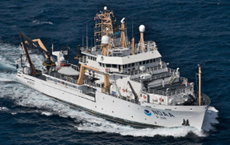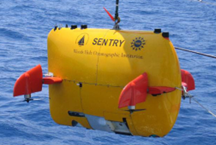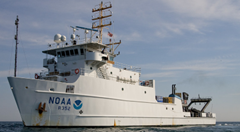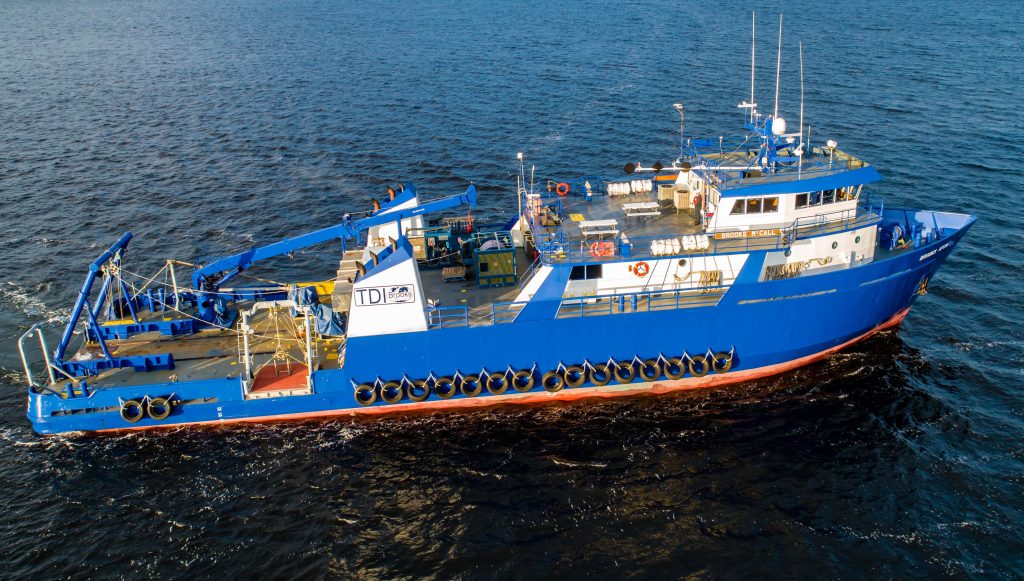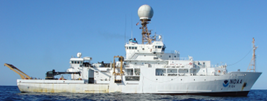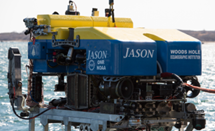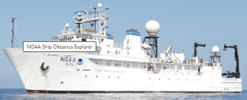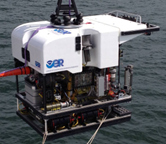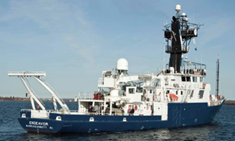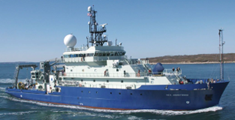The report for Contract M17PC00009, issued by the U.S. Department of the Interior, Bureau of Ocean Energy Management [BOEM]), titled “Deepwater Atlantic Habitats II: Continued Atlantic Research and Exploration in Deepwater Ecosystems with Focus on Coral, Canyon and Seep Communities”, has been submitted to BOEM for final editing and publication. This report will be the final deliverable of the BOEM Contract called Deep SEARCH, conducted in partnership with the U.S. Geological Survey. Initially, the study was a five-year, collaborative scientific research program focused on the outer continental shelf between Virginia and Georgia. The COVID crisis extended the program for another 18+ months. We surveyed the region’s deep-sea coral, cold-seep, and canyon communities as habitats of focus. Our overarching goal was to improve understanding of the functional role of these three habitat types in order to advance scientific knowledge and inform future management decisions. The intended application of the new science was to develop better predictive capacities for the community types encountered.
The sites were studied during five directly supported cruises, with detailed site descriptions of the geological, physical, chemical and biological conditions encountered. The results from six additional cruises conducted through collaboration with the ADEON project and NOAA-OER also contributed to the Deep SEARCH database .The research results, analyses and findings include the oceanographic, geological and geochemical setting of canyons, seeps and coral environments, deep-sea soundscapes, community structure and trophic function from microbes to fishes, population connectivity, life history of selected species, habitat suitability modeling deep-sea corals and seeps and educational outreach to the public.
Table 1. Research vessels associated with the Deep SEARCH project
Some of the more significant findings that have been produced from this study
- The newly named Richardson Reef Complex is now understood to be one of the largest cold-water coral reef complexes in the world. Furthermore, the Richardson Reef Complex is part of one of the largest coral mound provinces in the world, the Million Mounds, which extends from Richardson in the northeast and south across the entire Blake Plateau, and down along the Florida coast to the Jacksonville Mounds.
- The seeps along the continental shelf edge, visited for the first time, are remarkable for their extremely high rates of methane release and oxidation. Their chemistry fuels biological productivity that appears to also support local pelagic communities.
- Pamlico Canyon was found to be home to a very high diversity coral assemblage, to have high overall diversity of infauna, and to exhibit some of the highest densities of sediment infauna we have observed at this depth.
- Deep SEARCH data indicates high connectivity among all habitat and community types. For example, we see interactions between the diel vertical-migrating mid-water community and the benthic zone of the Richardson Reef Complex, as well as those of midwater organisms with the walls of the canyons and shallow seeps.
- The unique oceanographic conditions in the region have a corresponding influence on the various communities. The Gulf Stream cuts through the center of the study area, causing vertical mixing in its core down to 1,000 m. This promotes a rapid translation of food to depth and nutrients to the surface, which brings elevated trophic and genetic connectivity of the components of the ecosystem. These currents are highly variable at the seabed, (apparently) inducing a high degree of adaptive resilience of the deep-sea corals of the region in response to rapidly changing environmental conditions.
Through this study, TDI-Brooks has filled major data gaps for poorly known deepwater ecosystems, aiding the refinement of regional management strategies. Our improved understanding of the habitats and communities in offshore areas of the Atlantic Large Marine Ecosystem augments the capacity to predict the distribution of sensitive areas concerning the potential development of energy and marine minerals managed by the Bureau of Ocean Energy Management. Table 2 shows some project details.
Table 2. Project Details
| Study Title | Deepwater Atlantic Habitats II: Continued Atlantic Research and Exploration in Deepwater Ecosystems with Focus on Coral, Canyon and Seep Communities – “Deep SEARCH – Deep Sea Exploration to Advance Research on Coral/Canyon/Cold seep Habitats” |
| Report Title | Deepwater Atlantic Habitats II: Continued Atlantic Research and Exploration in Deepwater Ecosystems with Focus on Coral, Canyon and Seep Communities – “Deep SEARCH – Deep Sea Exploration to Advance Research on Coral/Canyon/Cold seep Habitats” Final Report |
| Report Number | BOEM 2023 -xxx |
| Completion Date of Report | May 2023 |
| Number of Pages | 876 |
| Cumulative Project Cost | $ 3,923,511.00 |
| Principal Investigators | Cordes, Erik E., Demopoulos, Amanda, Bernard, Bernie B., Brooke, Sandra, Brooks, James M., Joye, Samantha, Miksis-Olds, Jennifer, Quattrini, Andrea, Sutton, Tracey, Wolff, Gary A |
| Study Products | Project Data Project data was submitted to the following data repositories.
Publications and Presentations Cruise Reports
|
Figure 1. Deep SEARCH area showing BOEM wind leases NOTE: along with protraction areas, methane seeps, L. pertusa sites and deep-sea coral Habitat Area of Particular Concern.
About TDI-Brooks International, Inc.
TDI-Brooks is a pioneer in offshore geochemical exploration and heat flow measurement. They are a scientific data acquisition services company specializing in multi-disciplinary oceanographic projects covering; offshore geotechnical field services, environmental baseline surveys, geochemical “seep hunting” exploration and heat flow for oil and gas, offshore survey projects including oil and gas, wind farm, metocean, seabed mining, dredging, LNG and multi-disciplinary oceanographic and high-end environmental chemistry, renewables and marine sciences. Environmental, geochemical, and geotechnical services are complimented by onshore laboratories located in College Station, Texas. Laboratories are staffed with highly skilled scientists and chemists who have worked in partnership with federal and state agencies as well as the private energy and environmental industry for over 27 years.
TDI-Brooks has over 27 years of vessel chartering and management experience and currently operates five (5) research vessels, Brooks McCall, Miss Emma McCall, Gyre, Proteus and the Nautilus. These are multi-use vessels suited for a wide variety of oceanographic research duties for the offshore renewables and energy sectors. The Brooks McCall and Miss Emma McCall are both U.S. registered, and services the U.S. East Coast, Gulf of Mexico and Mexico. The Gyre and Proteus are Vanuatu registered, fully SOLAS compliant, and serve clients globally. The TDI-Brooks fleet is operated within a robust Safety Management System and all vessels are regularly vetted by client marine assurance groups and a part of the OCIMF Offshore Vessel Inspection Database (OVID). Our field services are supplemented by high quality analytical and geotechnical laboratories located in College Station, Texas.
TDI-Brooks was formed in mid-1996 by Drs. James Brooks and Bernie Bernard. Headquartered in College Station, TX with a remote domestic office located in Houston, TX and strategically placed offices around the globe. TDI-Brooks has a staff of over over-hundred and thirty individuals including fourteen Ph.D. level oceanographers, geochemists, biologists and geologists, hydrographers, geophysicists, mariners, cartographers, engineers, GIS and CADD specialists who perform surveys and produce deliverables of the highest quality. The company has international affiliates in Port Harcourt, Nigeria (TDI-Brooks Nigeria Ltd.) and Rio de Janeiro, Brazil (GSI-Brooks) with branch offices in Colombia (TDI-Brooks Succursal Colombia) and Mexico.
About BOEM
The Bureau of Ocean Energy Management (BOEM) is an agency within the United States Department of the Interior, established in 2010 by Secretarial Order.[1] The oil, gas, and renewable energy related management functions formerly under the purview of the Minerals Management Service (MMS) were delegated to the BOEM and its sister agency, The Bureau of Safety and Environmental Enforcement. Specifically, BOEM is responsible for managing development of the nation’s offshore resources in an environmentally and economically responsible way.

